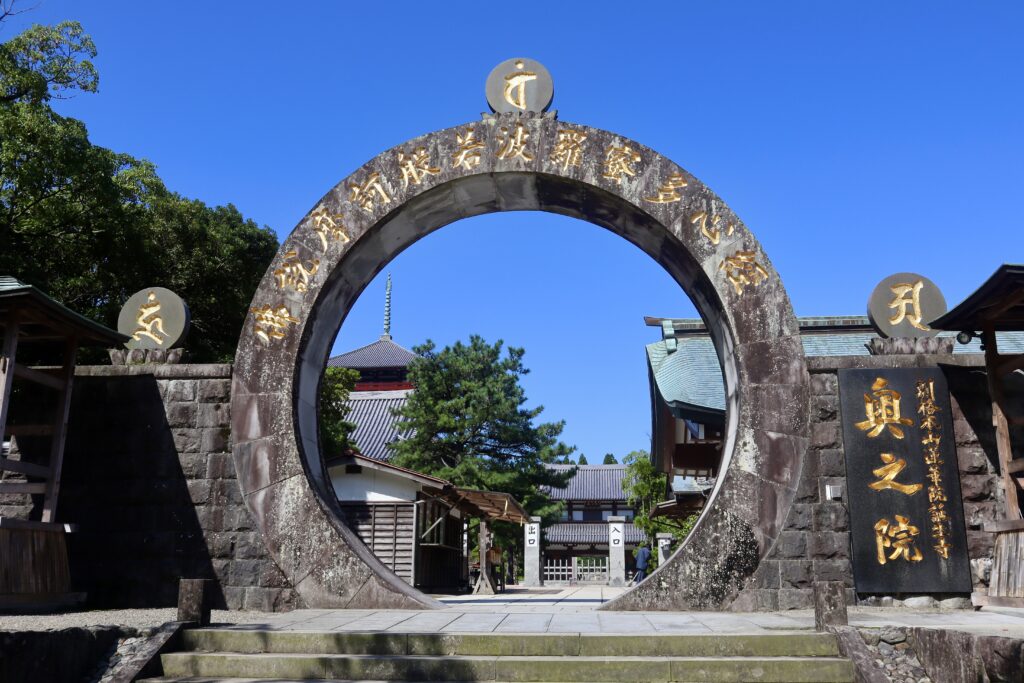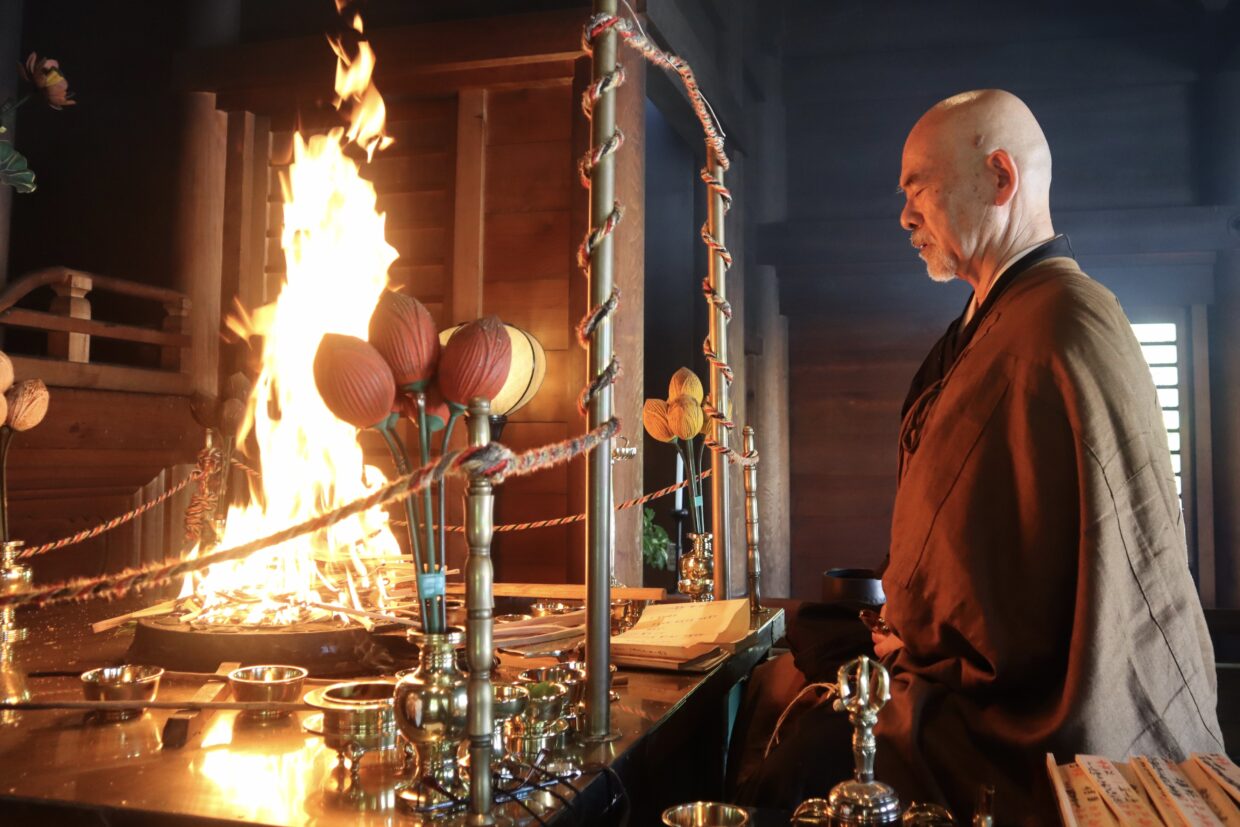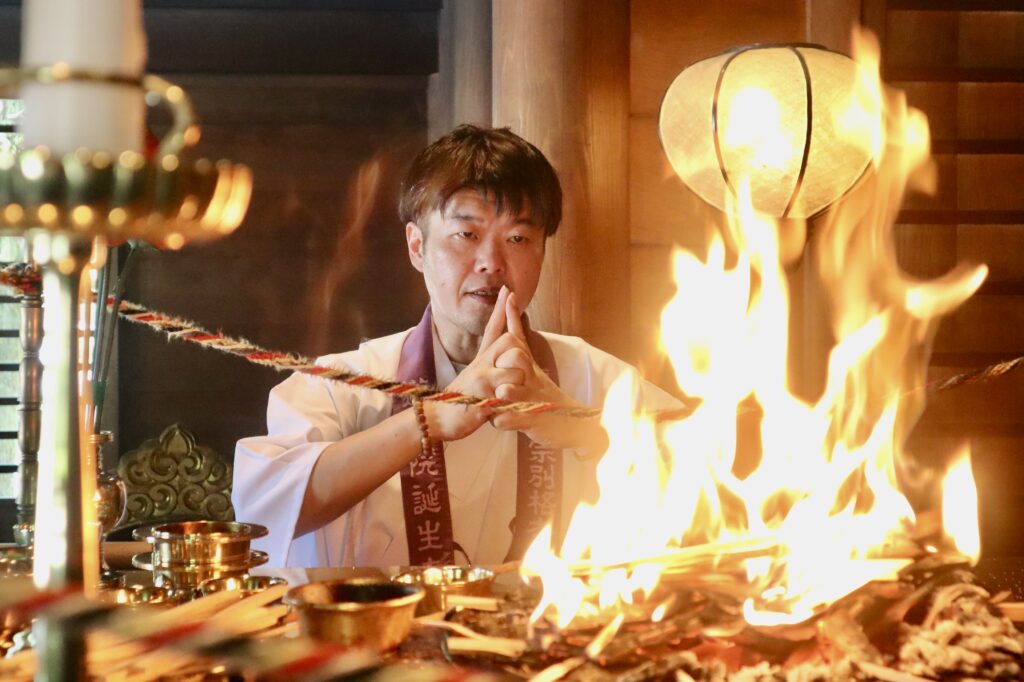Have you heard of Goma or Homa? Both mean fire rituals that you can see at Shingon and Tendai sects of Japanese esoteric Buddhism. Originally, it is one of their ascetic trainings so it is not usually open to the public. But nowadays, the rituals became open in some temples and you can see them easily in webpages. In Kumamoto, you can see the ritual right in front of you at Rengein Tanjoji Okunoin temple (蓮華院誕生寺 奥之院) in Tamana City (玉名市), the northern part of Kumamoto Prefecture.
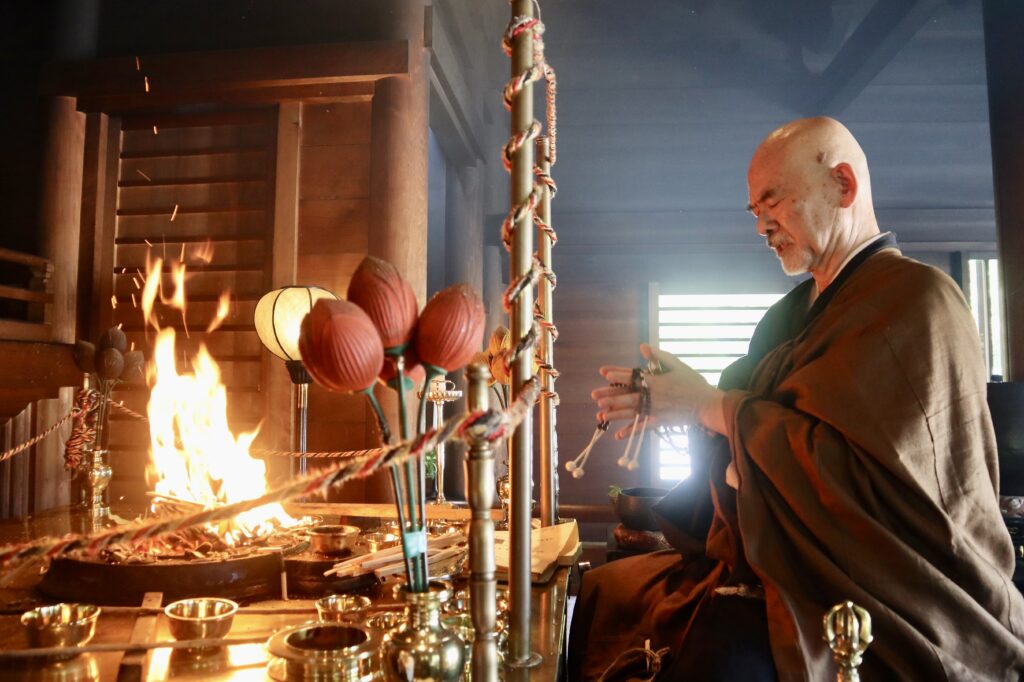
As I wrote in the last article, I had a chance to cover Goma fire ritual at Okunoin. Prof. Emeritus Juko Ito (Kumamoto Univ.), who became a monk of Shingon sect in 2018 after his retirement, offered me to take photos closely to raise awareness of Goma at the temple. Thus, luckily I could take his close-up photos performing the ritual.
Okunoin itself is a very attractive sanctuary to walk around in the middle of Mt. Shodai. The temple was designed under the concept of “a Buddhist sanctuary like a park where the general public can visit at ease and enjoy the time”. It is a temple with large sanctuary area and some attractive monuments and landscape. Let’s get to know Goma fire ritual and explore the world of esoteric Buddhism.
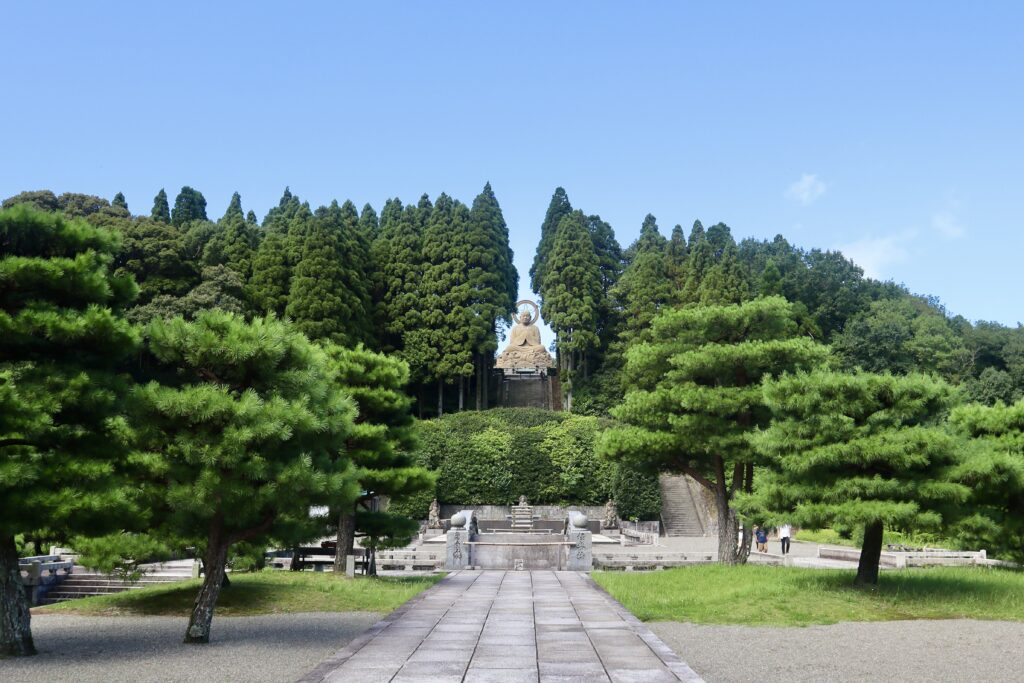
Contents
Goma Fire Ritual (護摩行) at Rengein Tanjoji Temple Okunoin (蓮華院誕生寺 奥之院) , Tamana City
Esoteric Buddhism and Goma Fire Ritual
First, let’s see what Goma fire ritual is and how they proceed it. Goma is performed in Shingon and Tendai sects in Japanese Buddhism but also in Tibetan Buddhism. Its origin dates back to the ancient Indian Brahmanism and supposedly to the fire worship of ancient Iranian Zoroastrianism.
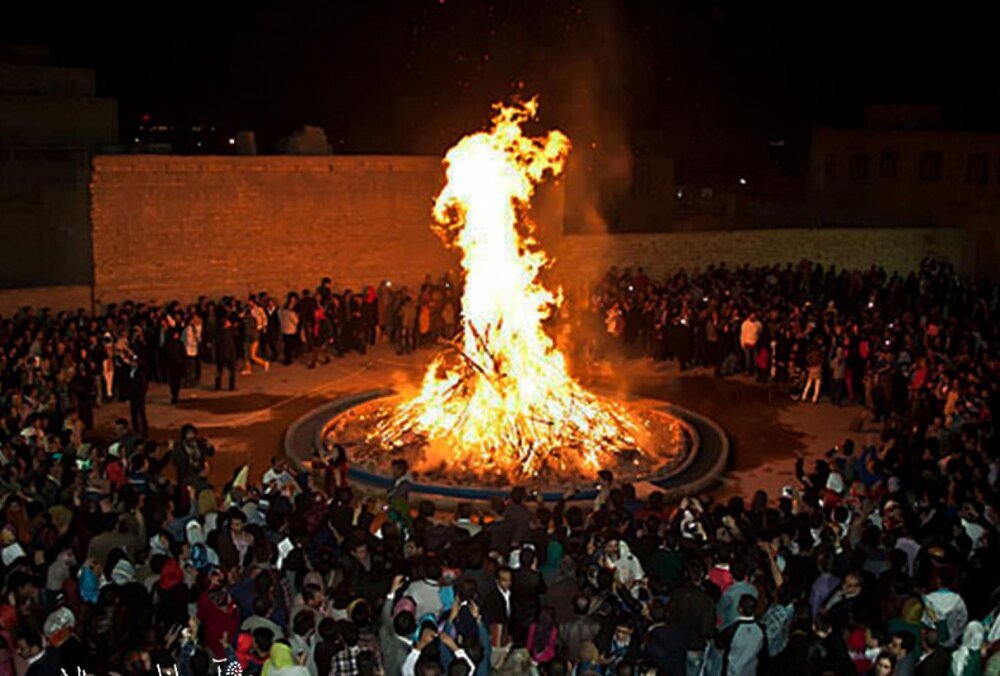
Source : https://www.tehrantimes.com/news/448226/Sadeh-the-ancient-festival-of-mid-winter-added-to-national
Buddhism was founded by Siddhartha Gautama about 2500 years ago. There are many sects of Buddhism now but the same goal of them is to let go of our worldly desires, achieve enlightenment and become a Buddha. Buddhism is broadly classified into two groups, esoteric and exoteric, and their approaches to achieve the goal are different.
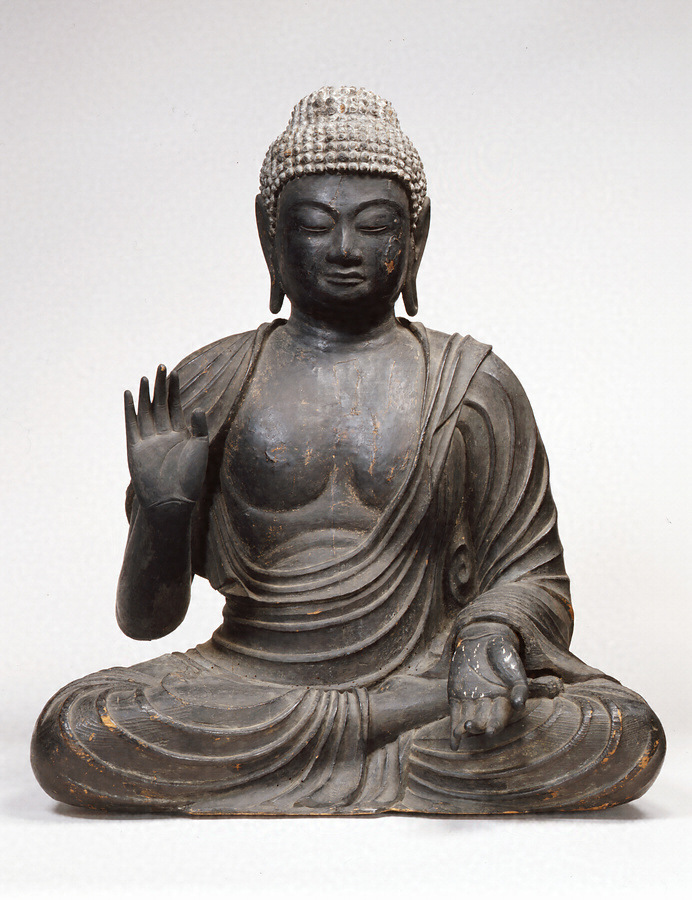
Source : https://bunka.nii.ac.jp/heritages/detail/512402
Esoteric Buddhism started in India in the 7th century and was brought to Japan through Tibet and China by Kukai(空海), the founder of Shingon sect and Saicho(最澄), the founder of Tengai sect. In the early 9th century, they both were chosen as students sent to China by the government and learned esoteric Buddhism. They brought back a lot of Buddhist sutras and altar equipments.
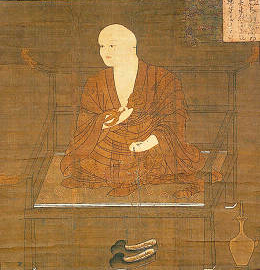
Kukai (空海)
Source : https://ja.wikipedia.org/wiki/空海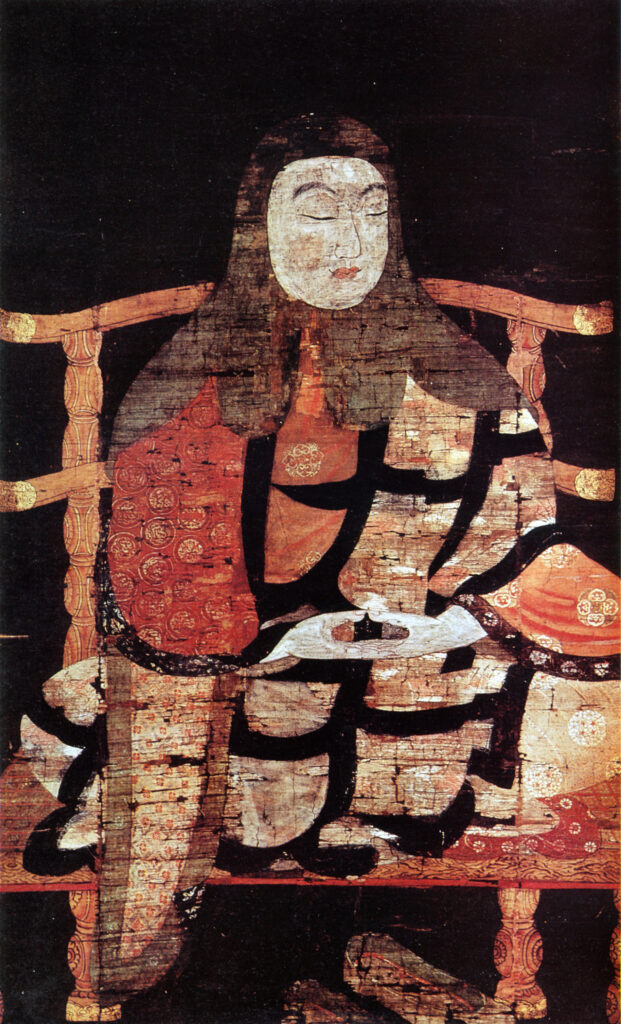
Saicho (最澄)
Source : https://ja.wikipedia.org/wiki/最澄
In esoteric Buddhism, their teaches are passed on by words of mouth from masters to disciples. They do practices privately among their sects. They have mysterious thoughts and practical trainings and they keep their Buddhistic teaching private in their sects. On the other hand, exoteric Buddhism teaches people Buddhism with easy and clear words and it is widely open to the public. They believe that if we take time, we can reach enlightenment through reincarnation (people’s souls are born again and again) and become Buddha. Comparing to exoteric Buddhism, esoteric Buddhism has unique practices, such as Ajikan (meditation, 阿字観), Sanmitsukaji (to be unified with Buddha, 三密加持), Goma (fire ritual, 護摩), etc. They believe that they will be a Buddha in this life time through those practices, not through reincarnation. Goma is one of the religious practices to get closer to enlightenment and you can see how they practice at Okunoin temple.
How do they carry out Goma fire ritual at Okunoin Temple?
Let’s see how do they carry out Goma. The details of the procedure are not open to the public, but to make it simple, monks make fire with goma-gi(護摩木) or small sticks of wood in the hearth, invite Buddhist deities to the table by keeping chanting, serve various offerings to them and pray for various wishes, such as diminishing natural disasters, peace and happiness for all living things, etc, finally to extinguish their bad karma. At the same time, they pray for visitors desires too, like healing of disease, wealth and happiness of families, success in business, etc.
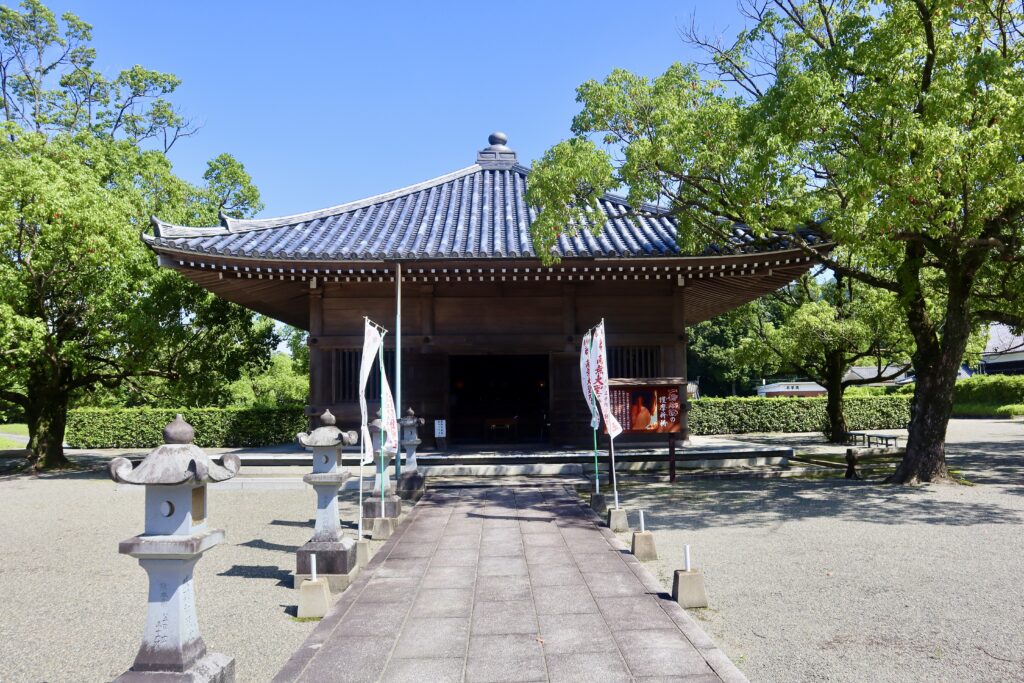
At Okunoin temple, Goma ritual is performed usually around at noon on Sunday in “Goma-do (護摩堂, Goma hall)”, a wooden building in Japanese traditional style. The interior is designed open with projecting central Goma stage, and visitors can observe the ritual closely from around. The hall plan is unusual and progressive because fire rituals were performed in a hidden way in the past.
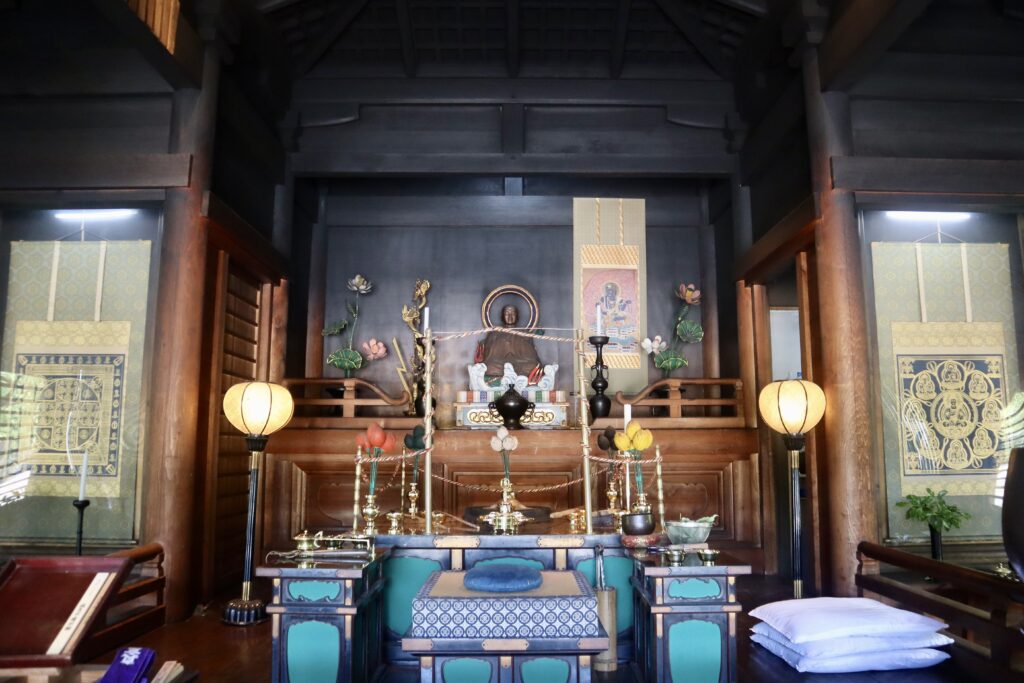
I’m going to show you how they perform Goma fire ritual at Goma hall in Okunoin. First, please watch this video below.
You can enter into the hall and see the ritual around the central stage. The ritual is performed on a low table of some 1.5 m square, the surface of which is covered with brass sheet not to be burnt by sparks. A hearth is set to make fire in the middle with many brass tools and containers around.
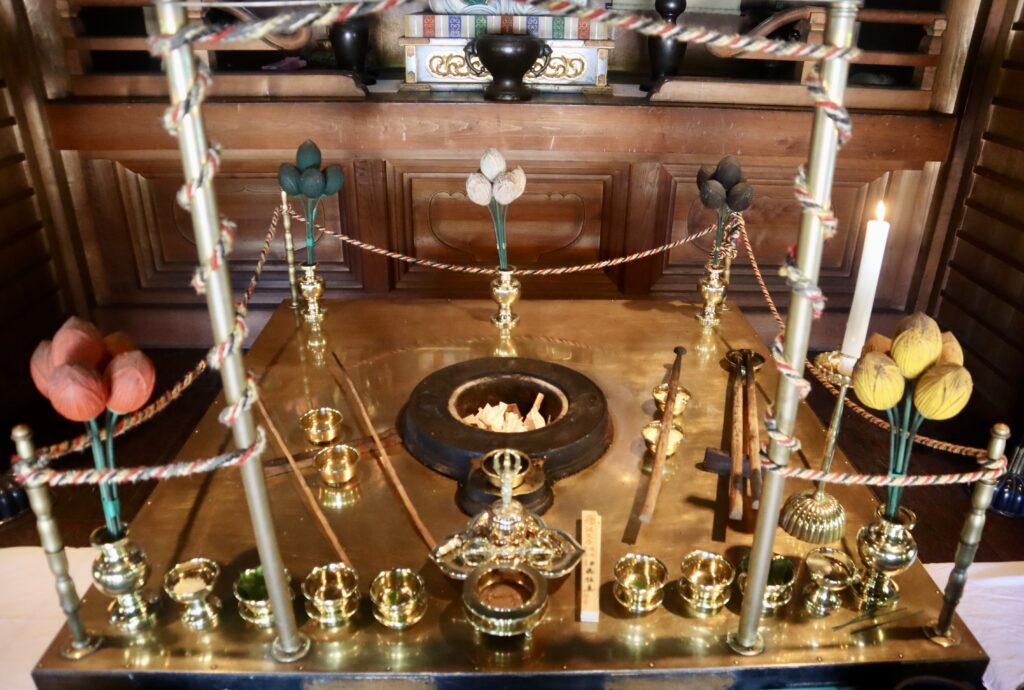
After one hour and a half of pre-ritual, the Goma ritual itself starts. During Goma, monks burn Goma-gi (護摩木fire wood sticks) with some other offerings in small brass containers.
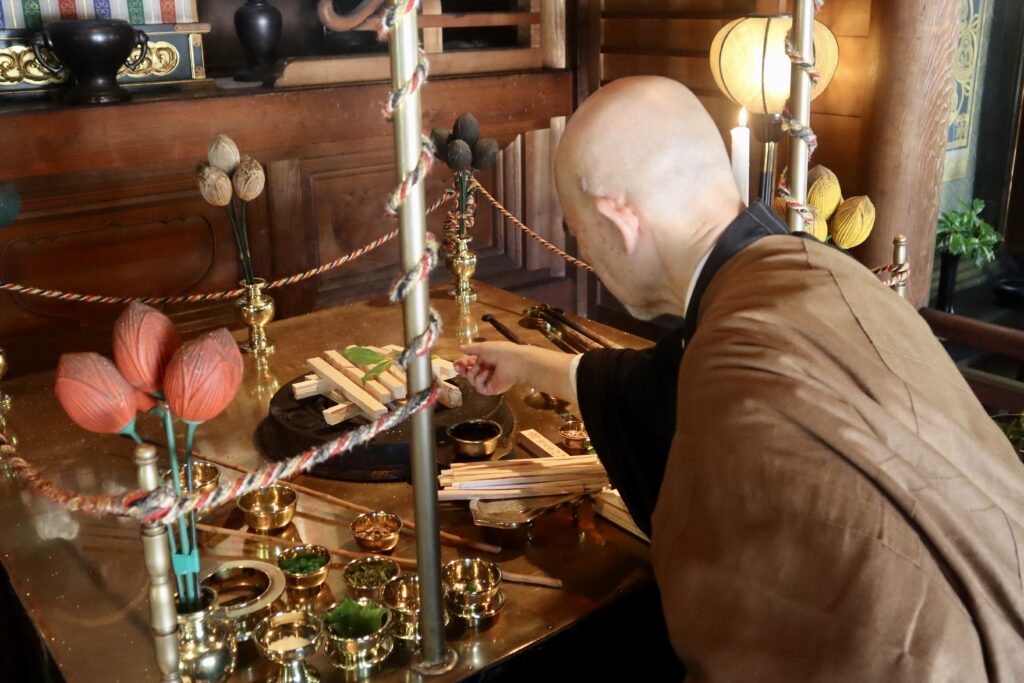
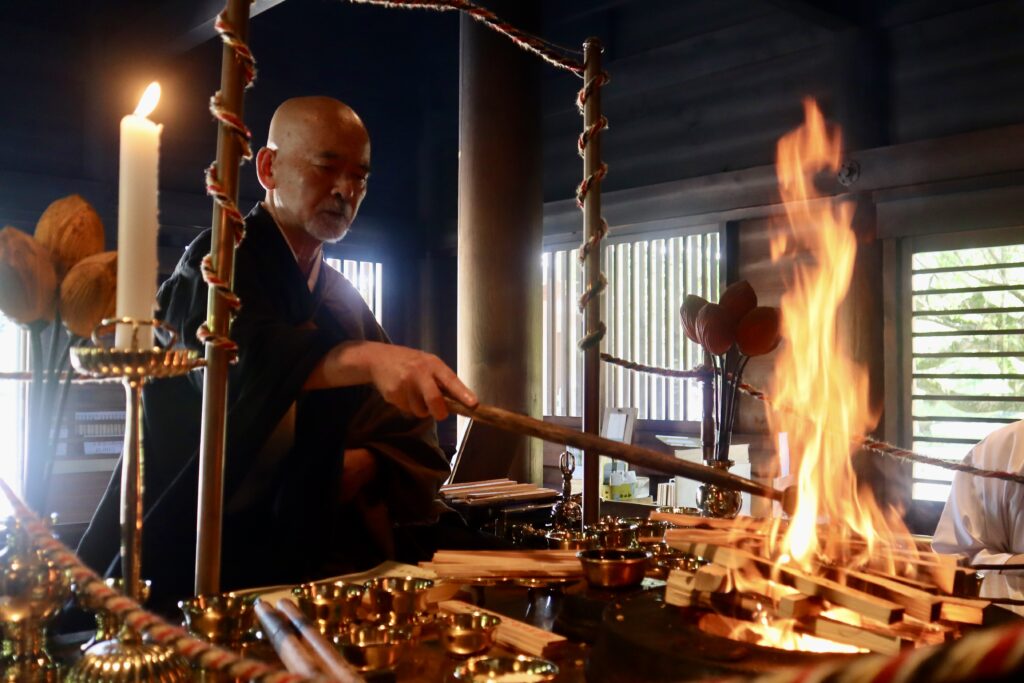
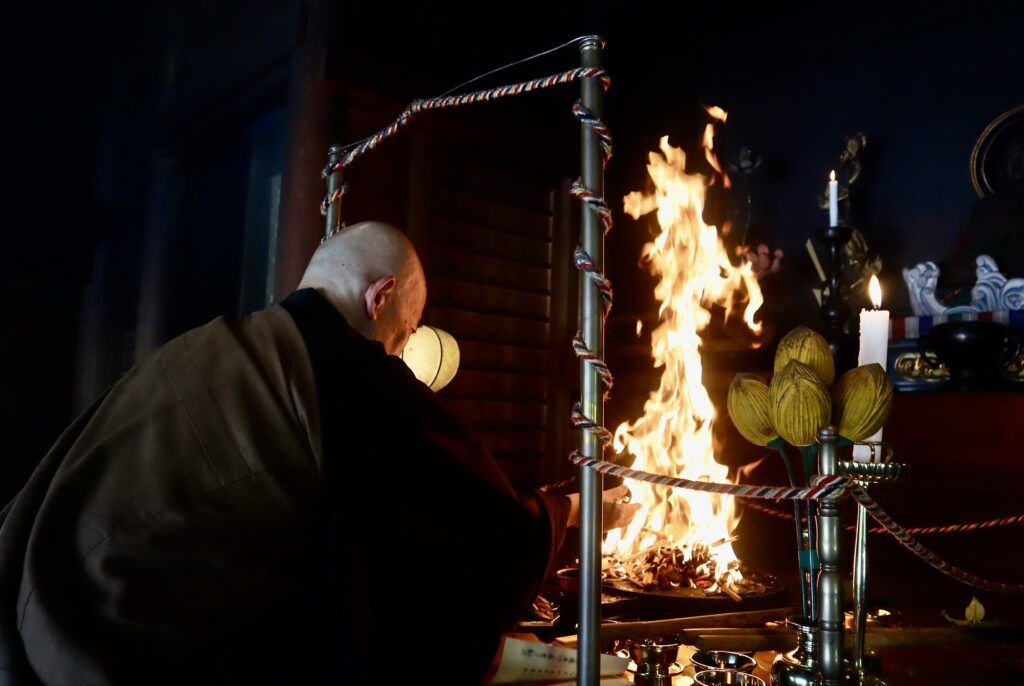
The fire rises up occasionally to some 1.5 m at highest, and its incessant wavering of mysterious flames in the dark and quiet hall attracts us in the world of profound esoteric Buddhism. We can hear only the continuous chanting of the disciples around and occasional touching sound of scoop and containers.

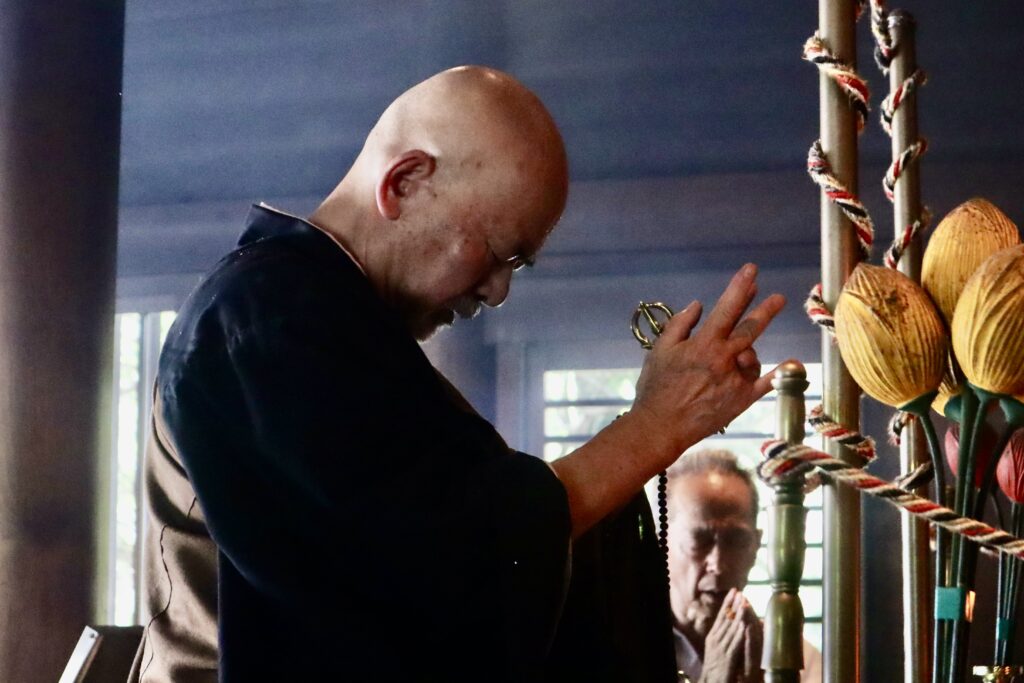
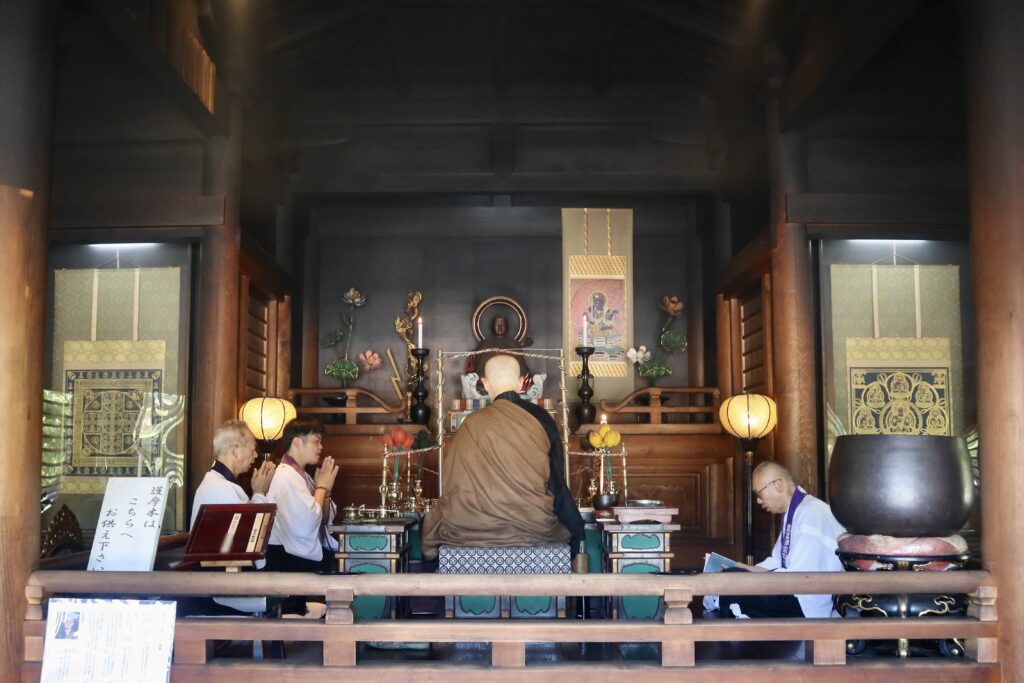
For visitors some small flat sticks are prepared to offer. They are called soegoma-gi (添え護摩木 or additional goma sticks). You write your own wishes on them with your name and address, for example, what you want to ward off, such as praying for a departed soul, good health, success in work and study, etc. Monks burn them to offer your sticks for your wishes to be realized.
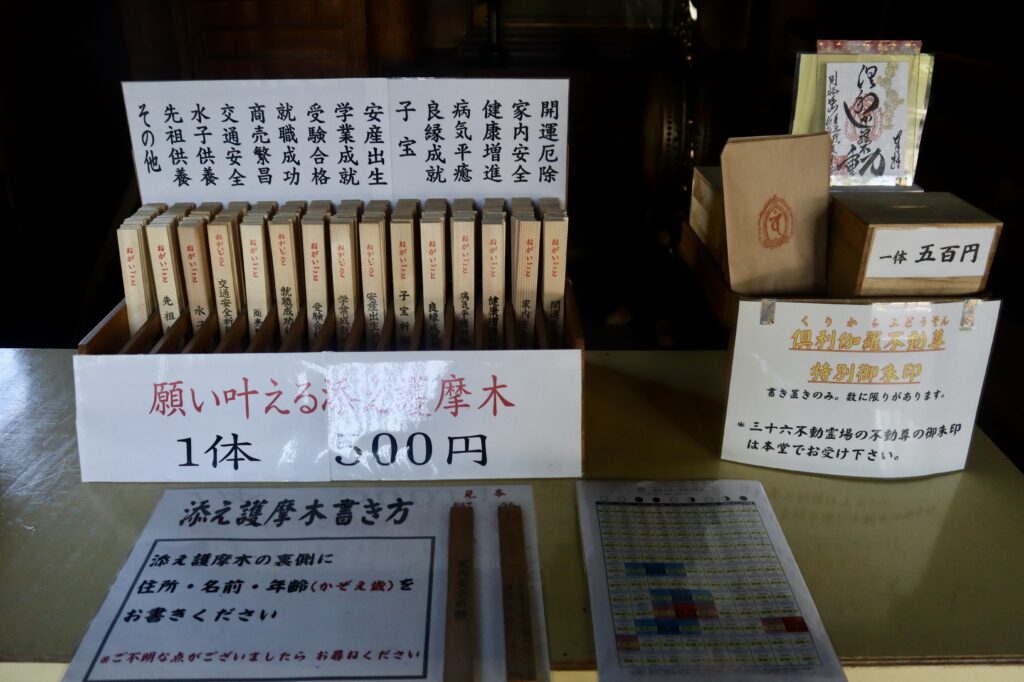
Visit Okunoin and explore the world of Buddhism through Goma Fire Ritual
Japanese esoteric Buddhism has become very popular also among foreigners these days. Many of them visit famous Mount Koya (Koya-san), one of the main sacred places of Shingon sect in Wakayama Prefecture, and join Goma fire ritual. In Shikoku island, there has been long a tradition of pilgrimage (四国遍路, Shikoku Henro) to visit 88 temples. Kukai, the founder of Shingon sect, started this in 9th century, and nowadays many followers including foreign visitors walk the same route of 1200km in the island.
Due to these trend of esoteric Buddhism, Prof. Ito thinks that there must be a reason why people are attracted to Buddhist practices. He performs Goma wishing that people will have more compassion and this world will become a better place. What I was mesmerized at most was how passionately people pray in Okunoin. While I was taking photos, I saw people coming into the hall, writing their wishes on Soegoma-gi stick and praying seriously. It is such a beautiful thing to pray for someone and something. Okunoin itself is a nice place to walk around. I hope you will visit them and explore the world of Buddhism through Goma fire ritual.
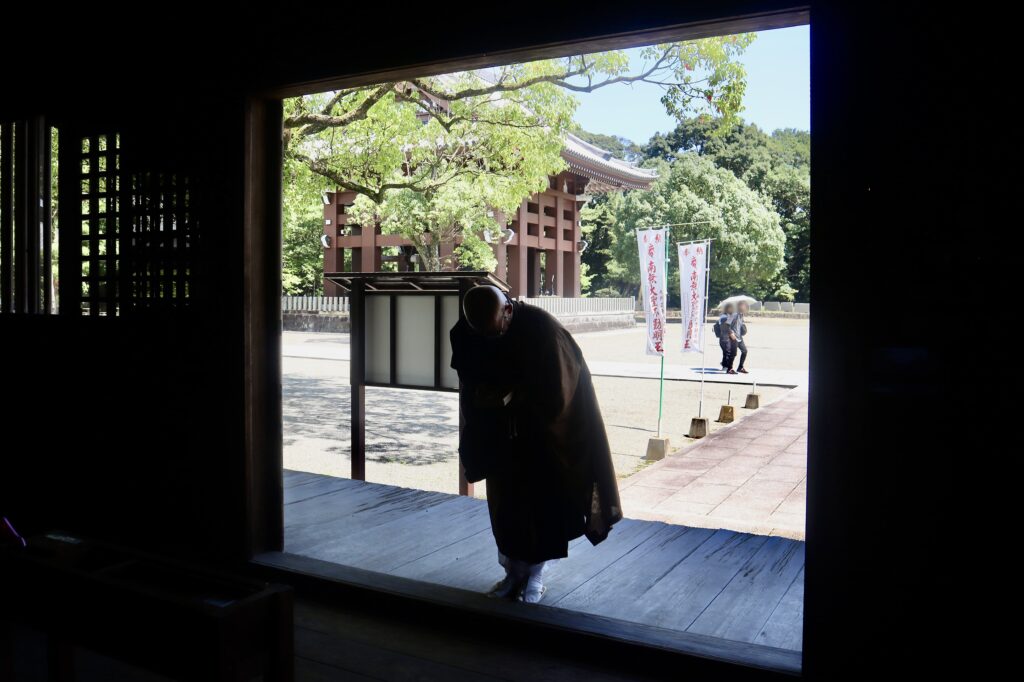
Information and Links
Official Website : http://www.okunoin-ren.jp/index.php
Open at 9am and Close at 5pm
Entrance fee : 200 yen
It takes about 15minutes by car from JR Tamana St. They don’t have a public transportation to the temple so if you do not have a car, taking a taxi will be a good choice.
For inquiry about Goma fire ritual: 0968-74-3533, info@rengein.jp
